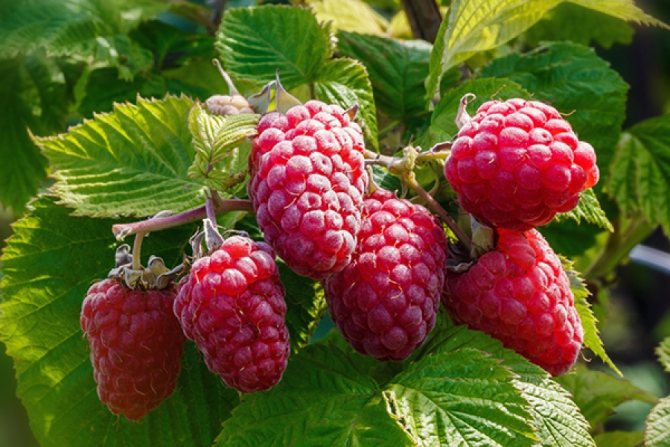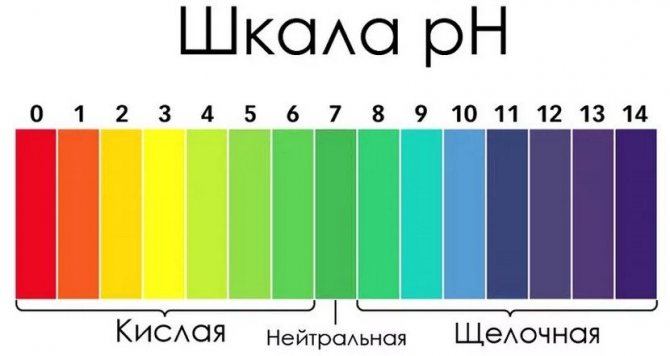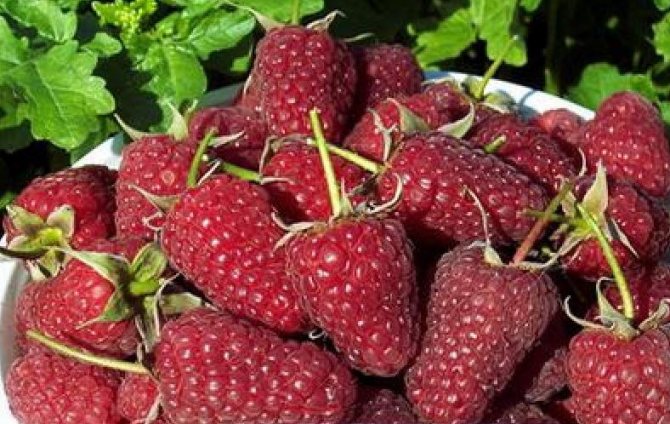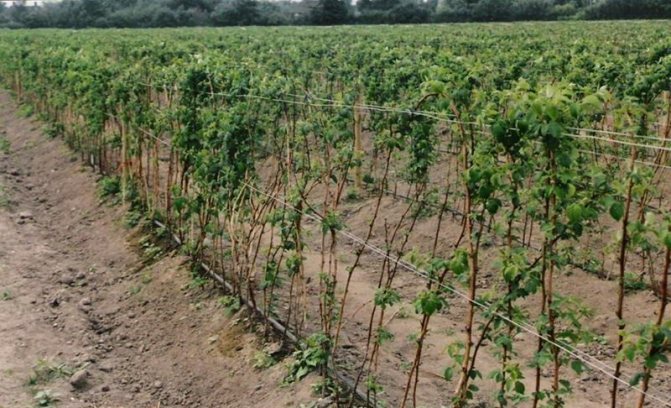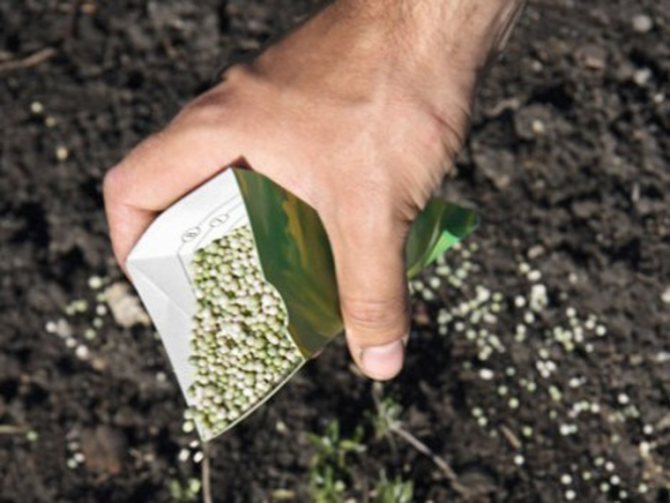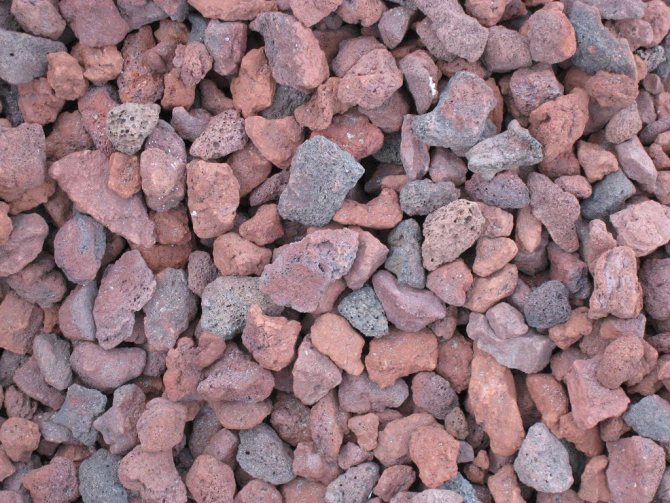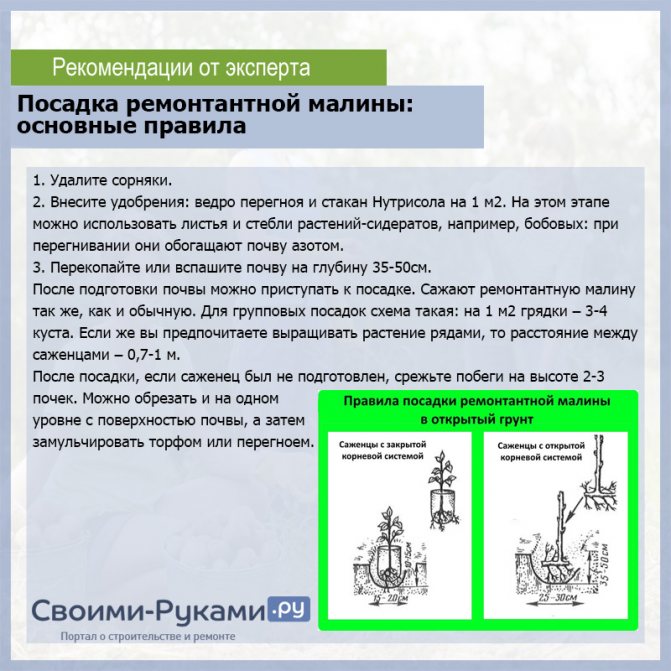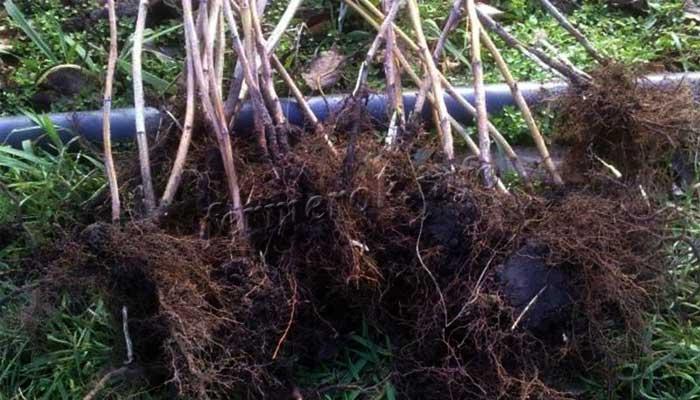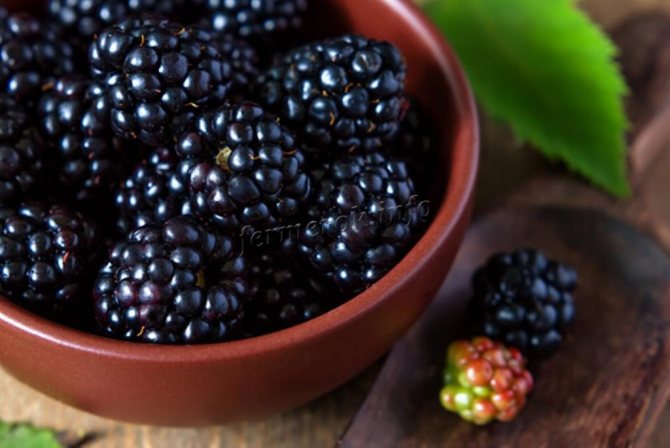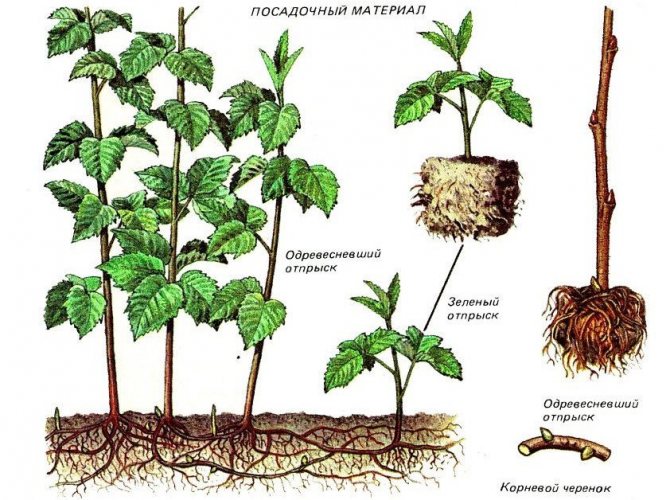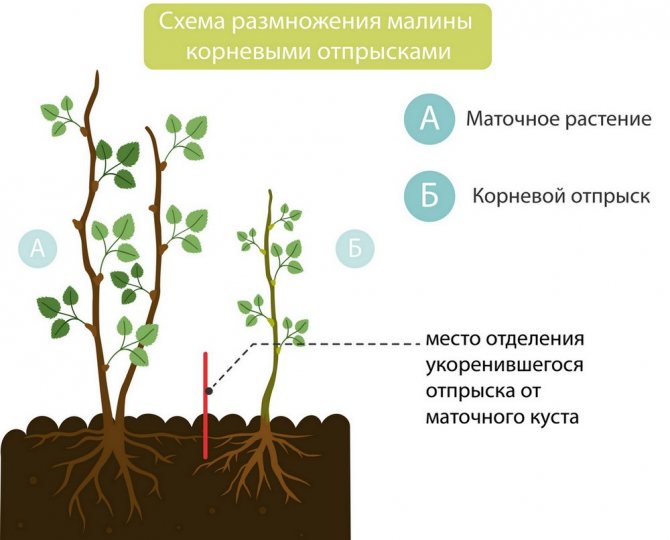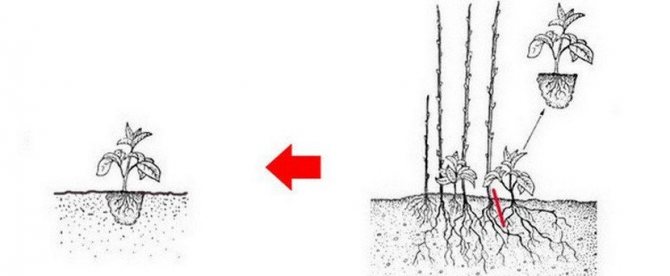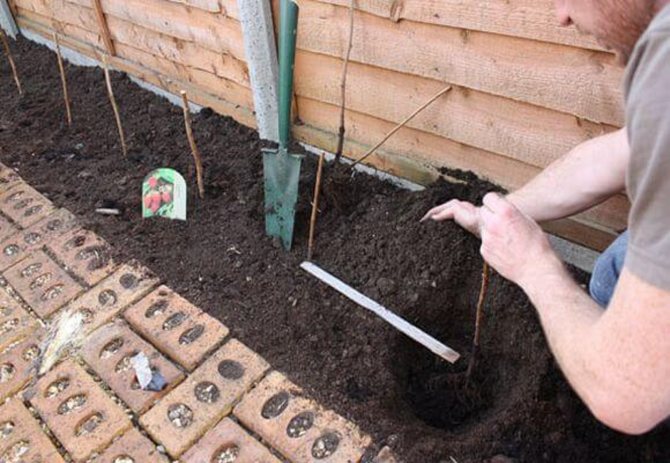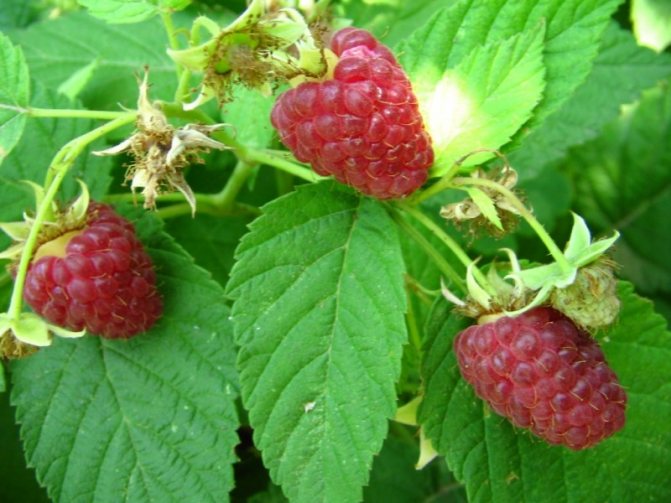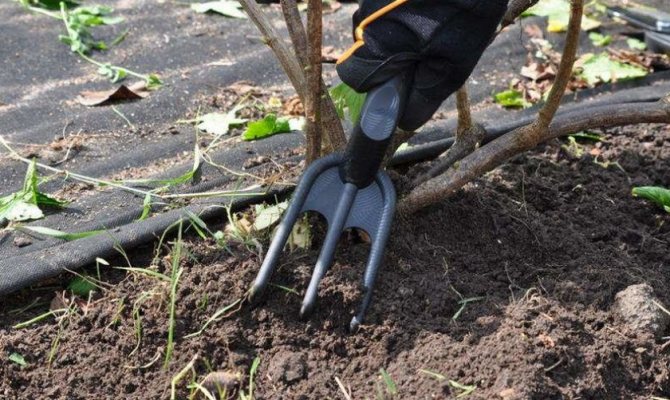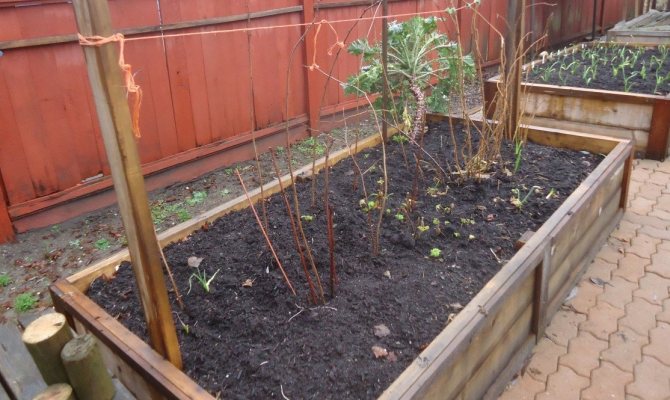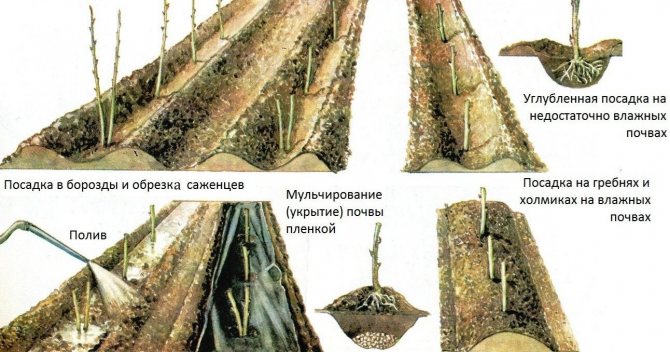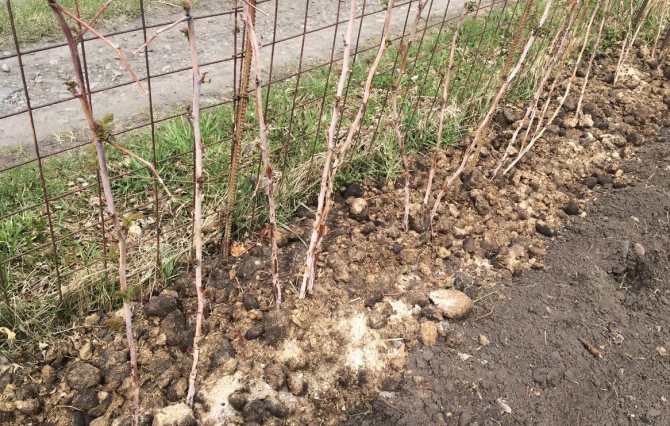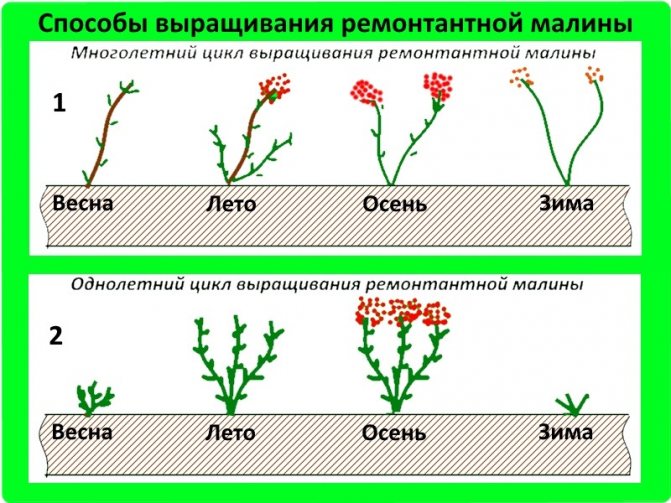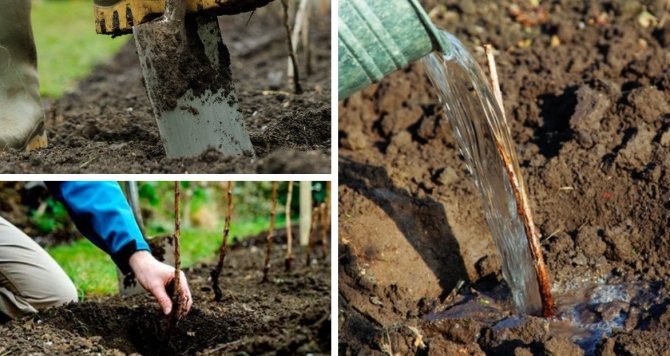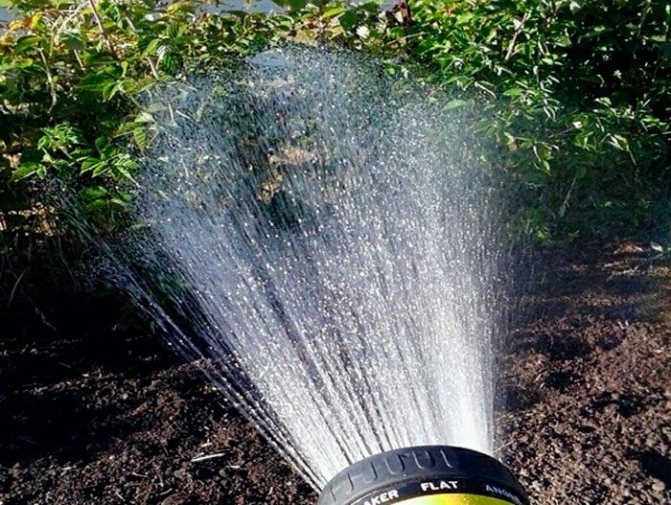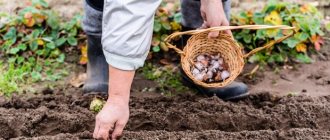Repaired raspberries are a real breakthrough in the selection work of scientists. Its popularity has not subsided for several decades, despite the fact that among gardeners there are still disputes over the suitability of this or that pruning or methods of growing remontant varieties of raspberries. And caring for her cannot be called too simple, although in many ways it is much easier than for ordinary raspberries. In general, novice gardeners are most interested in how to care for remontant raspberries, since opinions sometimes differ here, because each gardener has his own unique experience. And it strongly depends, both on the climatic characteristics of the region where raspberries are grown, and on the characteristics of a particular raspberry variety.
Soil preparation
In order for the remontant raspberry to immediately grow well, it is important to choose the right place for it. She loves lots:
- solar;
- protected from the wind;
- fertile;
- drained;
- loamy.
- neutral, with pH 5.8-6.8.
Raspberries are allowed to be planted in sandy and sandy loam soils. But then we must not forget about regular fertilization and feeding. If the soil turns out to be acidic, it is lime. Suitable for this:
- dolomite flour;
- limestone;
- marl.
Very good for raspberries if the site has been previously planted with green manure crops. Good choice:
- mustard,
- rye,
- lupine.
They can be sown in the middle of summer, and a month before planting raspberries, they can be embedded in the ground. A flat cutter or a shovel for digging is suitable for this. Professionals advise not to plant planting material in places where nightshades grew before: peppers, potatoes, tomatoes.
The earth on the eve of planting is dug up together with fertilizers. To do this, the following funds are applied to 1m2 of the future raspberry tree:
- humus –2 buckets;
- high-moor peat - 2 buckets;
- superphosphate -1 glass;
- potassium sulfate –1 glass.
Instead of individual minerals, you can use complex ready-made fertilizers.
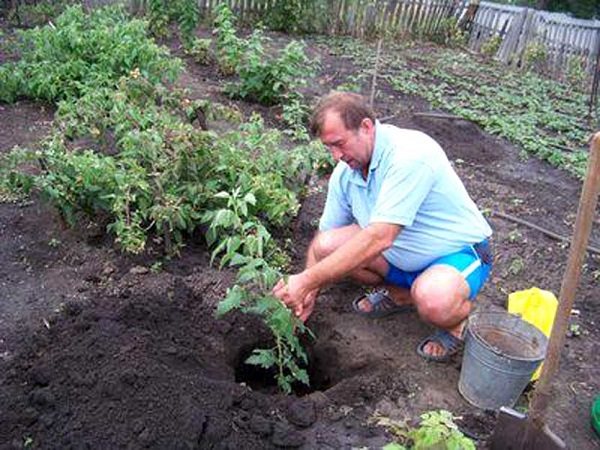
Landing dates in different regions
Repaired raspberries are allowed to be planted and propagated throughout the entire growing season, but when planting in spring or autumn, it is necessary to take into account the climatic features of the region.


When planting in autumn, the seedlings need to have time to take root before the onset of frost. They winter better, and in early spring they will immediately start growing. In the southern regions of Russia, Ukraine and Belarus, autumn planting is carried out from late October to early November and is completed 3-4 weeks before the onset of frost. In the central regions of Russia, a favorable period lasts from early September to the first decade of October, and in the northern regions of the Urals and Siberia - from early to mid-September.
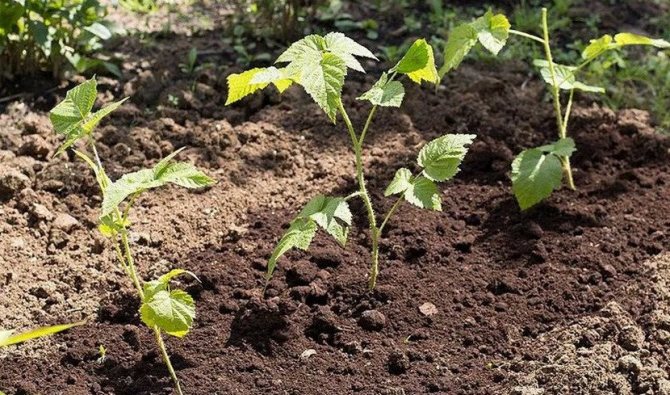

Spring planting is carried out when the weather is warm enough for the seedlings to take root. Wait until the threat of frost has passed. In the southern regions, work begins from the first days of March, in the central regions - from late March to mid-April, and in the northern regions - from late April to early May.
How to choose the right time for boarding
The fall period is not always equally good for planting raspberries. If you manage to do everything before mid-October, then the seedlings will get stronger. Falling snow will protect them from frost.Having planted a little later, it will be difficult for raspberries to adapt to negative temperature changes.
The main sign for starting planting is a formed replacement kidney. It should be fairly visible on the root collar.
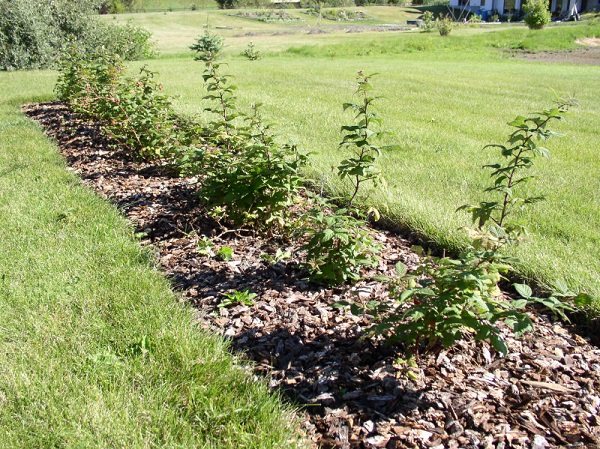

Why do you need a raspberry transplant
Regardless of the variety and types of raspberries, after 4-5 years after planting, raspberry bushes will yield a smaller crop. Not only will the number of fruits decrease, but also their size. The taste of the berry can also deteriorate. This is due to the fact that the bush does not get the nutrition it needs as a result of depletion of the soil in this area.
Therefore, you should periodically rejuvenate the raspberry tree. If this is not done, the bushes will begin to give not only fewer berries, but also shoots. This can lead to the gradual degeneration of the raspberry tree. To prevent this, an autumn raspberry transplant is required.
Preparation of seedlings
Annual seedlings or green suckers are used as planting material. Root cuttings are also suitable. The best for planting are seedlings of medium thickness, with a stem diameter at the base of 5 mm. The optimal length is 20cm. The roots should be intact and not very long. If this is a problem, then pruning shears and remove all unnecessary. You can do a little check before buying. To do this, you need to pry off the bark and cut off the kidney:
- the kidney must be alive and swollen;
- the bark has a greenish tint on the side adjacent to the wood.
It is helpful to dip the root system in a shampoo before planting. To prepare it, take:
- clay;
- mullein;
- water.
All are mixed and diluted to the consistency of sour cream.
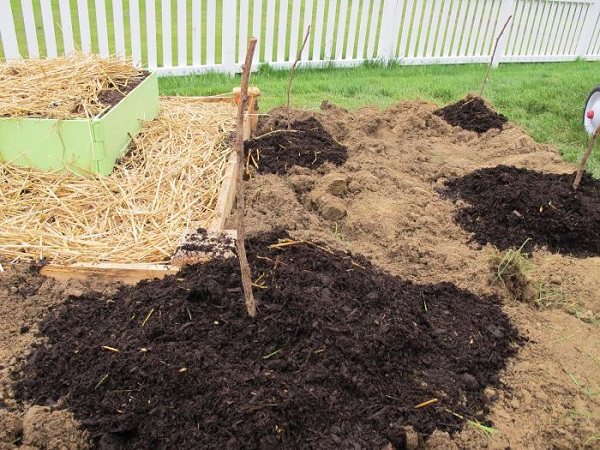

Possible mistakes when transplanting raspberries in the fall
Raspberries are one of the most delicious berries loved by gardeners. However, when transplanting it, you can make mistakes that can deprive the next year's harvest. The most common ones are:
- Early transplant. If you transplant the bushes at the end of summer, then rooting will occur too early. This will lead to the fact that young green shoots will appear on the bushes, which will freeze during the frost period. And this will cause a decrease in immunity and the possible death of plants.
- Insufficient pruning. Before transplanting, raspberry bushes must be cut off so that the ground part does not pull nutrients from the soil. This can lead to the fact that the nutrients and moisture are not enough for the proper rooting of the bush.
- Poor quality planting material. If the bushes have a poorly developed root system, it is better to refuse to plant them. For transplanting, only young seedlings must be selected.
Tips for transplanting raspberries will allow every summer resident to grow tasty and large berries on their site. And regular transplanting will increase the size of the raspberry tree and get a good harvest. In addition, an autumn transplant will avoid the need to carry out work in the spring - during the busiest period of the year for the summer resident.
How to properly plant remontant raspberries
Raspberry planting can be done in several ways. Everyone individually chooses what is right for him. To do this, use the following options:
- dimple;
- sulcus;
- trench;
- bush;
- capacitive.
All methods are proven and effective enough. The choice depends on whether you have enough strength to dig a trench or it is still easier to make holes. From the size of the planned plantation, the possibility of how to fill the grooves with fertilizers.


Planting in a container
This is a great option when there is a shortage of land in small areas. To do this, you can use any unnecessary barrels or buckets with a diameter greater than 50 cm. The bottom is removed. The container is buried in the ground and at the same time filled with fertile soil mixed with fertilizers.
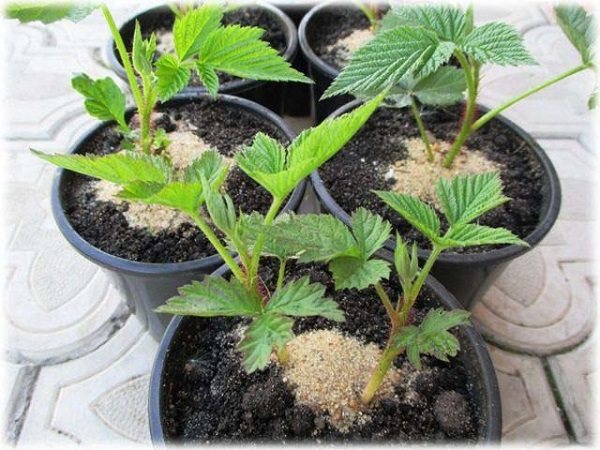

Trench landing method
The advantage of trenches is their long service life.Having laid the site, be sure that it will serve you for 10 years, at least. This method scares many with its laboriousness. But for obtaining high future yields, it is considered the best. A sufficient amount of fertilizer is evenly applied to the trenches. They need to be prepared 3 weeks before planting. For this, the place of the rows is marked with pegs. The most optimal trench sizes:
- length - 4-5 m;
- width - 60 cm;
- depth - 45cm.
A specially prepared soil mixture or nutrient mixture is introduced into the depression. Rotted manure or compost is placed at the very bottom. In no case should you use fresh manure. It will burn out the roots of young seedlings. Superphosphate and potassium salt or wood ash are evenly scattered on top. And at the very top - vermiculite or vermiculite. The removed fertile layer is added a little and mixed with a shovel.
The roots are well spread when the seedlings are laid in a trench. Make sure that they do not bend up. Sprinkle with earth evenly, it should penetrate well between all the roots. Hold the seedling with your hand, trying to ensure that the level of the root collar is located correctly. Its optimal location on a par with the surface. Deepening will lead to poor growth and even death. A high position will cause the replacement kidneys to dry out or freeze.
Planting is completed with watering and mulching. For good root survival, mulch is a prerequisite. It will prevent excessive evaporation and give the soil looseness.
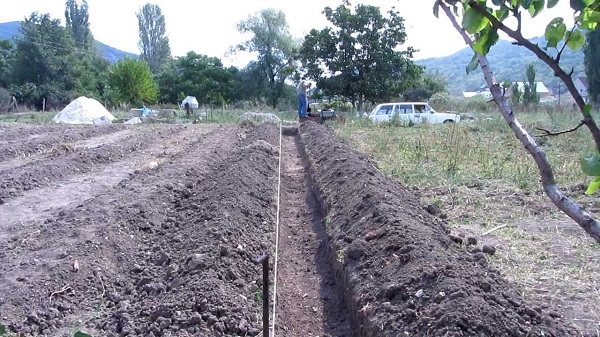

Landing in the pits
An easier way. Well suited for fertile land, when you do not need to add a lot of organic matter and minerals to feed the roots.
The indentations are made in the size of 40 * 40 * 40 cm. The distance between them is 70 cm. The distance between the rows is at least 1.5 m. Before planting, you can hold the roots of the seedlings for a couple of days in water with a stimulant. This will revitalize their root system, increase the survival rate.
The planting material is installed in the hole and the level of the root collar is monitored, sprinkling the hole with earth. It should be flush with the surface. If the soil is sandy and can settle significantly, then the neck is deepened by 2-4 cm. The raspberries are well watered. Each bush requires 5 liters of water. And sprinkle with mulch 7-10 cm thick.
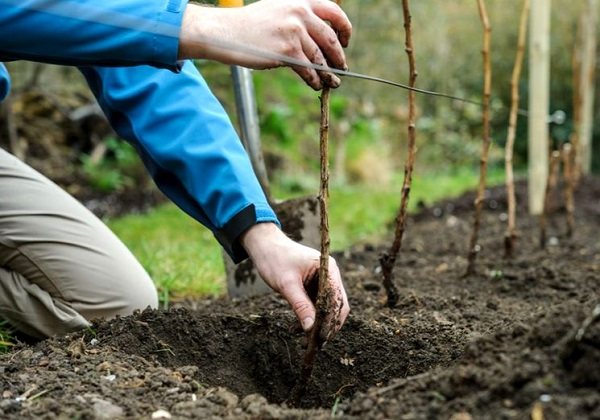

Bush method
The landing pattern is made in such a way that the following distances are observed:
- 1.2 m between adjacent bushes;
- 1.6 m between rows.
Already by 3-4 years of cultivation, the bushes become lush and high-yielding. They are easy to care for, easy to pick berries. When pruning, up to 10 strong shoots are left in each bush. Weak and diseased branches are removed when pruning.
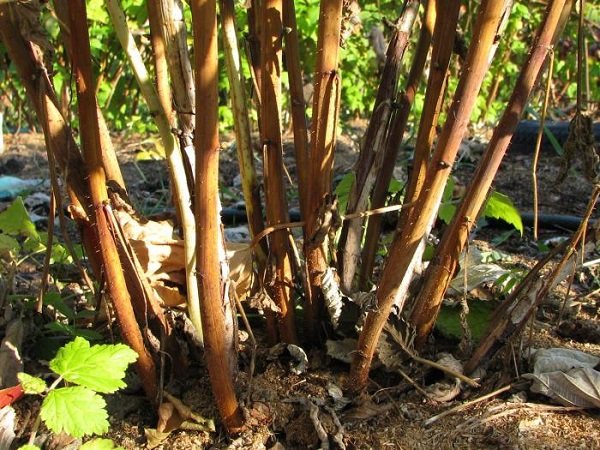

Furrow or row method
The shoots are planted in furrows up to 40 cm deep. The root system of the seedlings must fit completely in them. If fertilizers were not applied when digging the soil, they should be applied to the furrow. To do this, use: compost, superphosphate and potassium salt. The planting material is placed in a row at a distance of no closer than 70 cm. The correct spreading of the roots and the level of the root collar are monitored. Sprinkle with top fertile soil.
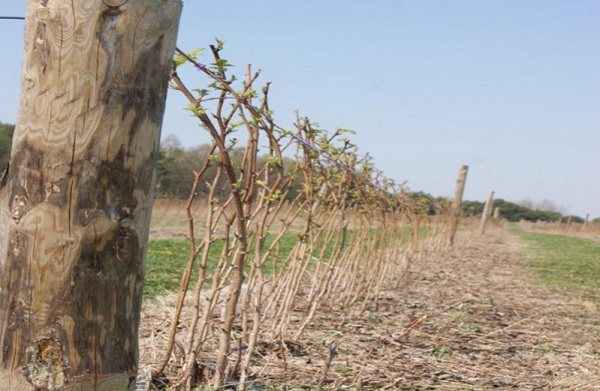

Advantages and disadvantages of autumn raspberry transplant
Transplanting remontant raspberries in the fall has a number of advantages and disadvantages that should be taken into account when determining the optimal timing of work.
Benefits:
- Optimal weather conditions. At the beginning of spring, the weather is no longer hot, and there is a sufficient amount of moisture in the air and on the soil. This weather is optimal for the rate of release of young roots. In addition, the weather is more stable in autumn. During the spring, it can be quite hot during the day and temperatures can drop significantly at night. Strong temperature changes negatively affect the rooting rate of young seedlings.
- Plant juices in the cuttings.In the fall, the internal juices of the seedling are found primarily inside the cutting. In the spring, the plant spends the main strength on the growth of shoots, so it may not have enough strength for active growth and development of the root system.
- A wide selection and low cost of seedlings. In the fall, it is easier to purchase raspberry seedlings of the required variety. Plus, most farmers sell raspberries with leaves or even berries, so it's easier to assess the quality of the plant. In the spring, there are seedlings on sale without leaves, by which it is more difficult to determine their quality. In addition, the cost of raspberries in the spring is higher.
- After planting in the fall, no special care is required. In autumn, the weather itself creates optimal conditions for the rooting of seedlings. In this case, it is enough to fertilize the soil well before planting.
- A high percentage of rooting of plants during autumn planting. In spring, this figure is much lower.
Despite the clear advantages, transplanting raspberries in the spring also has a number of disadvantages that should be taken into account.
Disadvantages:
- The need to monitor the weather in order to choose the optimal period for transplanting. If you are late, plants may not take root, which will lead to their death.
- The inability to transplant late raspberry varieties in the fall.
Thus, the disadvantages of an autumn transplant are much less than their advantages. In the fall, young shards will receive all the necessary nutrients and a sufficient amount of moisture from the soil. And the appearance of fruits on such bushes can be expected as early as next spring.
However, do not transplant the entire raspberry tree at once. Next summer, certain varieties may not produce berries during the autumn transplant, so you may not be harvesting.
Arrangement of trellis
Without the construction of a strong trellis frame when growing remontant raspberries, which are distinguished by high shoots, one can not even dream of it. Therefore, its organization should be the first priority.
The optimal length for the location of the posts is considered to be 4 m. They are installed in boreholes 50 cm deep. The height above the ground is 1.5-2 m. The wire is used 4 mm in diameter, it can be slightly thicker. It is allowed into 3 levels. The lowest one is at a distance of 30 cm from the ground. It serves for tying up young growth, which can then be successfully used as planting material. The second level is at a height of 1 m, and the third is the top one - 1.5 m.
Shoots are tied at all levels, but they do it in such a way as to maintain a distance of 10 cm between them. This will help them withstand the weight of snow and strong winds. And the wire will not be damaged.
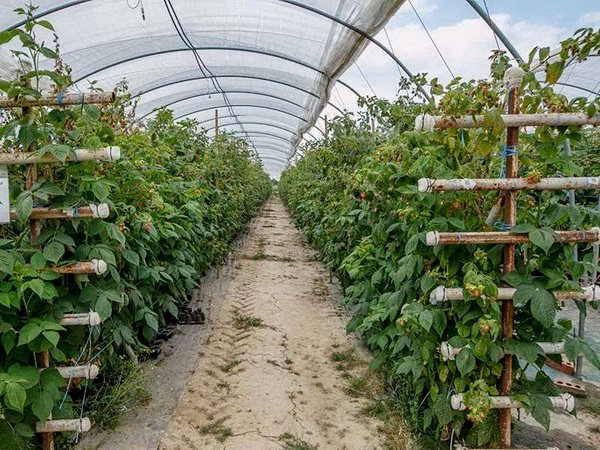

Watering and feeding the bushes after transplanting
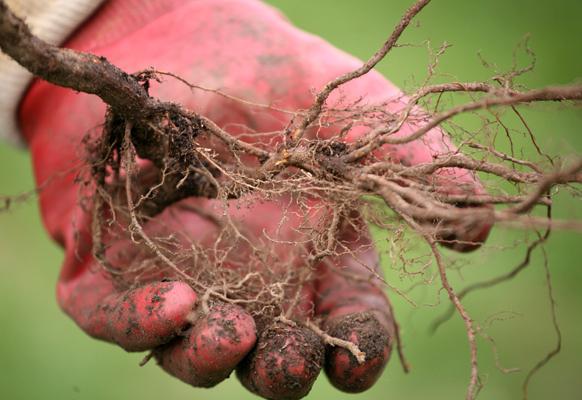

If autumn is warm and dry, raspberries need watering even after harvest. She especially needs moisture after transplantation. Adequate watering will allow the shrubs to take root faster. But if it rains regularly and the air temperature is low, watering can be completely stopped. However, before the onset of frost, at least 15 liters of water must be poured under each bush. The bushes will absorb enough moisture to help them survive the winter.
Also, raspberries need nutrients, which they can get from the right feeding. For feeding, it is recommended to use compost or rotted bird droppings, wood ash and potash salt.
See also: "Diseases of raspberries and their control".
Mulching
In order for the remontant raspberry to grow well after planting, it must be mulched. As mulch, you can take:
- sawdust;
- straw;
- hay;
- leaf litter;
- shredded branches;
- rotted weeds.
Mulching materials will retain moisture at the roots of raspberry seedlings, and also protect them from freezing during winter frosts. It will help in the prevention of fungal and bacterial diseases.Mulch will give useful minerals and organic matter to the soil, keep the fertile layer from washing away and weathering.
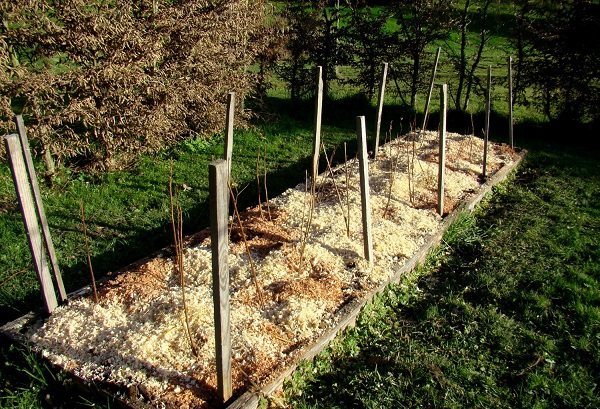

Which variety to choose
When choosing a raspberry variety, it is necessary to be guided not by the attractiveness of the description of the berries, but by the possibility of their successful cultivation in a given region. The wrong choice will only cause hassle, loss of time and frustration.
Important! Repaired raspberry varieties are more demanding to care for than ordinary ones, and with a lack of lighting, moisture and nutrients, the yield will be worse than declared.
Varietal diversity provides a wide selection of varieties of early, middle and late ripening, large-fruited, high-yielding, as well as with berries of various colors. The combination of several varieties with different ripening periods will allow you to enjoy the harvest throughout the season.
Among the most popular for the southern and central regions of Russia, Ukraine and Belarus are offered Indian Leto, Bryansk Jubilee, Hercules, Orange Miracle and other zoned varieties.
Indian Summer Berries round, medium in size, dark raspberry with sweet and sour taste. The bush grows tall and branched. The variety is winter-hardy, but prone to powdery mildew, purple spot and spider mite attacks.
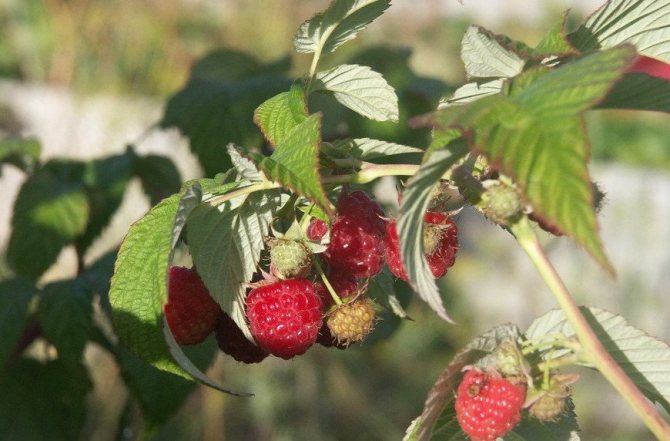

Bryansk Jubilee with beautiful elongated red berries grows into a small compact bush with weak branching. The commercial quality is high, the resistance to diseases is average.
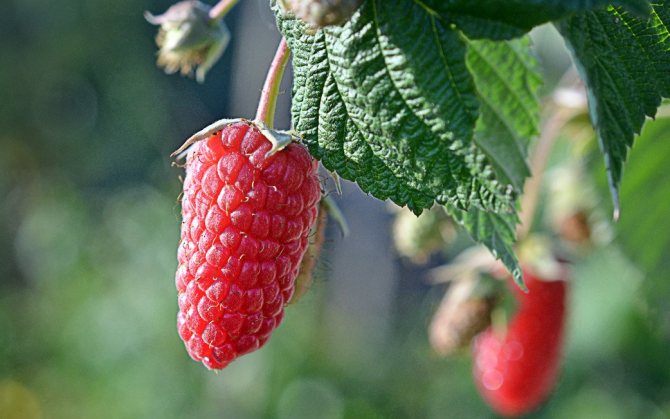

Hercules - a tall variety, but the volume of the bush is small. The berries are large with a ruby hue, the flesh is juicy and dense. Suitable for industrial cultivation. Possesses high resistance to fungal diseases and good transportability.
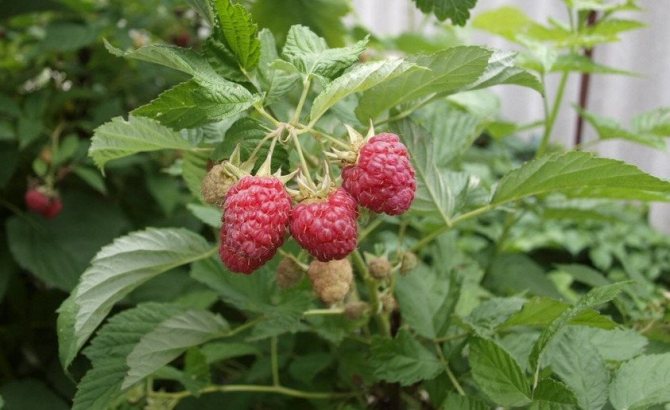

Orange Miracle differs in berries, elongated up to 4 cm, with color from orange to scarlet and high taste. The pulp is dense, tolerates transportation and storage well. The variety is compact, medium-sized, requires a garter to the trellis.
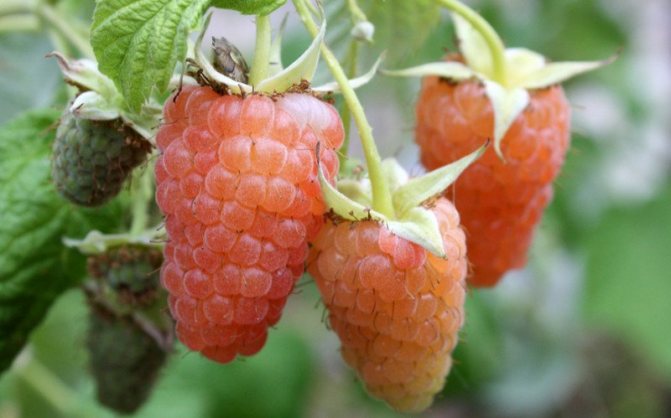

For colder regions of the Urals and Siberia, raspberry varieties are recommended. Inaccessible, Shiny, Gift of Siberia and others with increased resistance to adverse conditions.
Berries varieties Unattainable scarlet, large and have excellent taste and aroma. The bush is low, powerful and can withstand frosts down to -23⁰С.
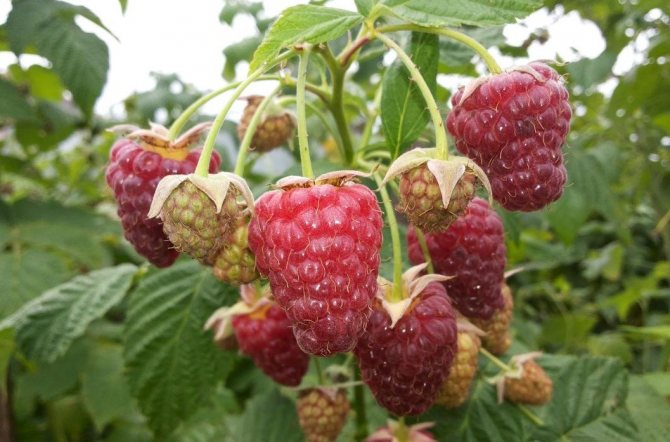

Variety Shiny characterized by gradual ripening of medium-sized berries with a sweet and sour taste. The fruits are firmly attached to the stalks and do not crumble when ripe. Resistance to frost and disease is high.
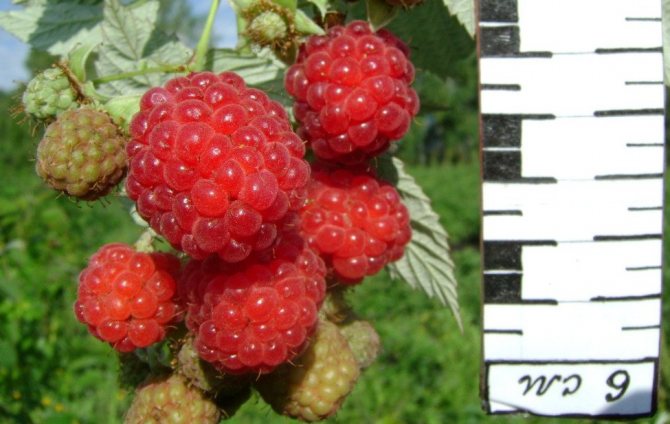

The gift of Siberia gives berries of a delicate peach shade with a pleasant taste and aroma. Bushes are powerful, tall. The variety is high yielding and resistant to harsh conditions.
Sowing siderates
Another useful final stage of planting remontant raspberries can be winter sowing of green manures between rows. For this, it is good to use plants that are resistant to low temperatures. Can be planted:
- rye;
- oats;
- wheat;
- mustard.
Strong shoots will appear in 2 weeks. Even if raspberries are already mulched, siderates can always be sown furrow or row by row. To do this, make a tape 10 cm wide using a herringbone. Seeds are scattered over it and sprinkled with earth or mulch. The green carpet will keep a lot of snow, protect from spring return cold snaps. In addition, it will make a huge contribution to increasing the fertility of the soil under the raspberry tree.
In order for the remontant raspberry planted in the fall to take root and bear fruit well, care for it must be regular. Timely pruning, watering, fertilizing, fertilizing, mulching are the main activities that can always be performed to achieve a high yield throughout the entire fruiting season.
Autumn care measures


Pruning remontant raspberries


How to prune raspberries correctly
In order for the bushes to be able to winter without loss and in the spring to fully stock up on the necessary vitality, it is imperative to complete the following points:
- Cut off dry and non-viable branches of black and dark brown color. Work starts from the top, so as not to accidentally delete the good branches with the bad ones. When cutting off 7-8 centimeters, you can see if there is juice and living tissue in the branch. Having removed the dried branches at the root, the rest are cut off by 25-30 cm so that they do not freeze in winter. In heavily overgrown bushes, you need to leave 60-70 cm of free space to move between them.
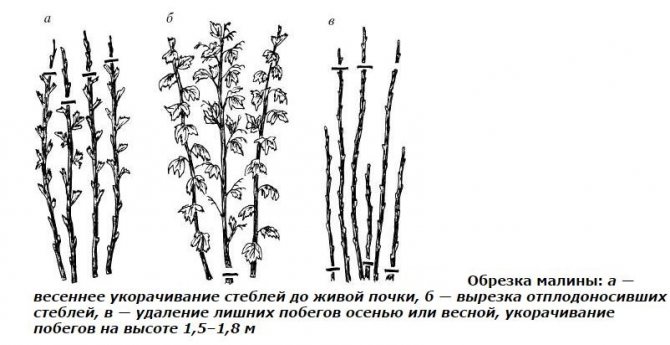

Three methods for pruning raspberries - The foliage from the bushes is shaken off from the roots to the top of the bush, wearing a thick glove, and burned away from the plantings so that pests do not fall into the soil where the bushes stand.
- The raspberry tree must be cleaned not only of leaves, but also of unnecessary grass and litter, in which small rodents want to organize their housing. Hibernating in a raspberry tree, animals greatly spoil healthy branches.
- It is necessary to bend the stems to the ground in order to hide them under the snow and thereby protect the bushes from freezing at temperatures below 25 degrees. Shoots must be collected in one bunch and bent to the ground or wrapped in a special agrofiber cloth.
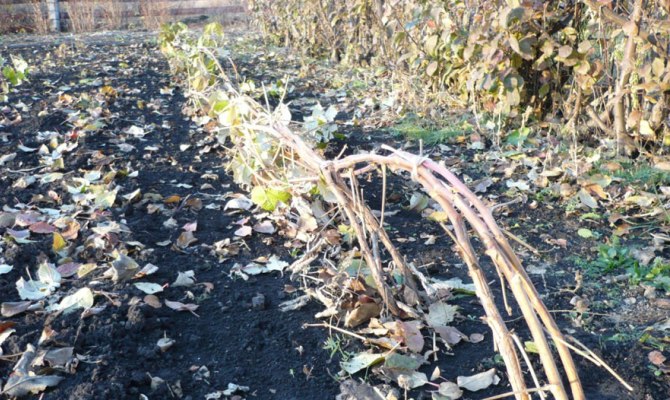

Preparing raspberries for winter - Do not add nitrogen fertilizers since mid-August, since the bushes continue to actively develop with nitrogen components for two to three months. In frosts, plants can die if they do not come to a dormant stage, when the growth and movement of substances stops.
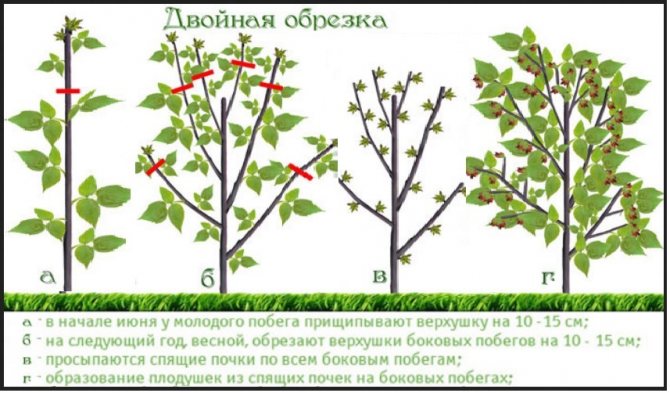

Double pruning raspberries
Careful implementation of all points will double the frost resistance of raspberry bushes. Then in the spring the plants will develop much faster and will certainly bring a good harvest to the caring owner.


Preparing raspberries for winter in stages
Transfer to an open area
Repaired raspberry planting and care. Now I would like to talk about the important points and nuances in planting this type of raspberry. Most of the farmers prefer to carry out the planting event in the second decade of September.
This is justified by the fact that it was at this time on the street that the most appropriate ratios of temperature and humidity indicators.
In principle, when it is not possible to plant the bushes in the fall, they do this in the spring. The vegetation is not too demanding, and therefore it safely adapts to any environmental conditions. For cultivation, it is best to choose an area with loamy soil enriched with nutrients.
Most often, raspberry bushes are placed in a well-lit area, protected from strong winds.
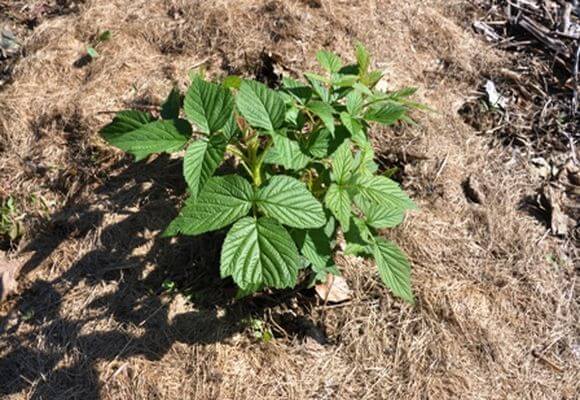

The principle of transplanting raspberries in the fall
It is not recommended to place a raspberry tree on the site where there were previously:
- peppers;
- beds of onions or potatoes;
- tomatoes;
- planting onions;
- apple trees or roses.
After you choose the right time and place for the plants, you need to tackle the soil. The soil needs to be dug up properly, and then fertilized. In the case when there is more mechanical composition in the ground, it is required to plow, adding high peat - 20 liters or humus to the ground. It also does not hurt to add potassium sulfide and superphosphate - in the amount of 1 cup each.
The planting process is carried out according to the following scheme:
- Depressions are dug on the site, so that the interwell distance is at least 70 cm. At the same time, a distance in rows of about 150-200 cm is also observed. It is highly undesirable to violate these norms, otherwise thickening will occur, which, in turn, will negatively affect on raspberries.
- The root system is placed away from the topsoil, while spreading it out. Part of the root collar is dug in to the same place as before planting.
- When shrubs are securely placed in the pits, they are covered with soil and slightly compacted.
- At the end of the procedure, garden residents are watered with water - 5 liters for each.
Reproduction
Repaired raspberries are propagated vegetatively in the same way as varietal ones, but they give young shoots much less and they grow weaker. There is also the possibility of propagation by seeds, but the probability of retaining varietal traits of about 60% and the long growing period make this method ineffective compared to the rest.
Root offspring
The fastest and most gentle way to propagate raspberries, used throughout the growing season. Choose sprouts that have reached no more than 25 cm in height. They are dug out with a part of the rhizome and immediately transplanted to a permanent place. To protect from direct sunlight, wooden shields are installed on the southern, eastern and western sides of the beds, shading the seedlings for 2 weeks.
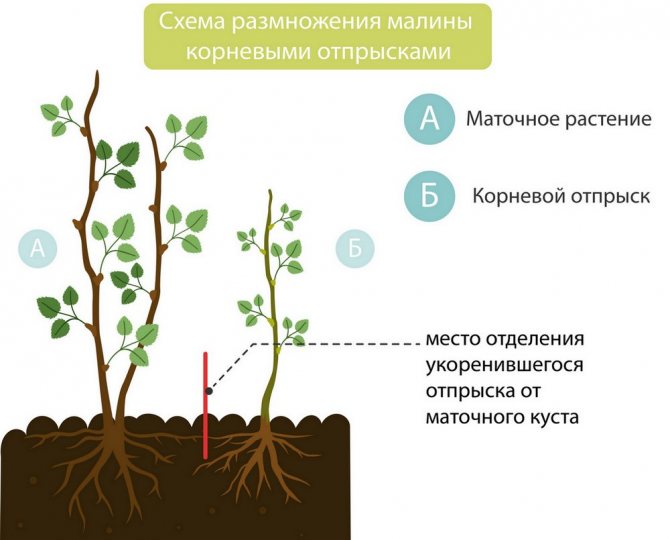

Remontant varieties form few such offspring, so they practice a different method of obtaining them. In the fall or spring, the central branches are cut down from the bush designated for reproduction, along with part of the rhizome. The part remaining in the ground forms many offspring, which, as they grow, are used for planting.
Root cuttings
Root cuttings are harvested in the fall. The dug out rhizome is cut into pieces 10-15 cm long. They can be planted immediately, covering them with spruce branches for the winter to protect them from freezing. If desired, root cuttings are prepared for spring planting.
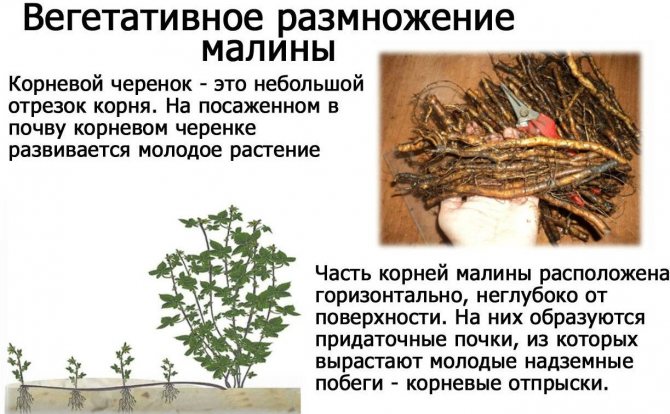

The rhizome is not cut, but sprinkled with wet sawdust and sent to storage in the basement or cellar. During the winter, many growth buds will awaken and the amount of planting material will increase significantly.
Green cuttings
Suitable for reproduction are green cuttings up to 5 cm high, growing at the base of the rhizome. They have the strength and energy to quickly grow their own root system. They are harvested in the spring, cutting with a knife at the root to a depth of 3-5 cm so as not to damage the mother plant.
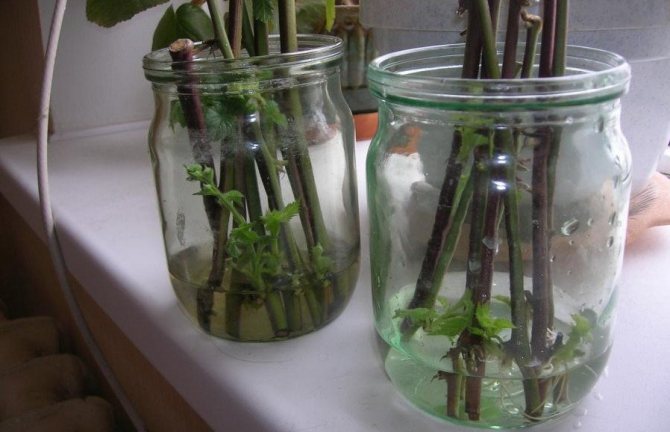

The sprouts are planted in a greenhouse for growing and shaded. A month later, when the required number of roots is formed, the seedlings are transplanted to a permanent place.
General rules for caring for raspberries in spring


Raspberry remontant: care and cultivation. Due to the fact that remontant varieties of raspberries are distinguished by high yields, the removal of nutrients from the soil in this berry is much greater than in summer varieties. If in the fall the raspberry bushes were cut to ground level, then the main spring concern of the gardener will be feeding the plants with mineral and organic substances.
Top dressing is carried out after last year's fallen leaves are removed from the surface of the earth, weeds are removed, and the soil is loosened. After swelling of the buds, one viable is left, removing all dried ones. Top dressing should provide raspberries with nitrogen to build up green mass. Use urea at the rate of 20 g per 10 l of water or ammonium nitrate 30 g per 10 l of water.
In order for the top dressing to be balanced in terms of the content of nitrogen, phosphorus and potassium, complex formulations containing the main macronutrients, vitamins and growth stimulants ("Kemira", "Master") are used. Phosphorus and potassium can be added to the raspberry plant with wood ash. After loosening the soil, 1 glass of ash is scattered under each bush, or root dressings are made at the rate of 1 glass of ash per 1 liter of hot water. After the water has cooled, it is filtered and poured under each bush, 0.5 liters.
When to take cover off a raspberry
Raspberry remontant: care and cultivation. If remontant raspberries are grown as a two-year-old shrub according to the regime of traditional raspberries with protection from winter cold, then in the spring they start with the fact that all covering materials are removed. After that, the raspberry bushes are examined and all shoots damaged during the winter are removed. This will protect the raspberry tree from the outbreak of fungal diseases. It should be remembered that along with the sun, the pests that overwintered on the raspberry bushes also come to life.
How to tie raspberries to a trellis
Raspberry remontant: care and cultivation. Raspberries are tied up in order to prevent damage to the shoots. The fragility of the shoots manifests itself during rains, with gusts of wind. Tall shrubs with abundant fruiting will first bend and then break. Some types of raspberries grow up to 2 meters in height. The tied up bushes are well lit and ventilated. This promotes amicable fruit setting and high yields. Tying is carried out before the awakening of the first buds.


Raspberry garter methods
There are several ways to tie raspberries in spring:
- to the stakes - several stems are fixed with a bundle, the stake is placed in the center of the bundle. In this case, the attachment point will be at a height of 2/3 of the length of the stems. The height of the stake should be 50 cm higher than the longest stem.
- a garter to the stakes with a fan - half a raspberry bush is attached to each stake. As a result, on one side of the stake is part of one bush, and on the other side of the other.
- The trellis method involves attaching the branches of the raspberry bush to the posts, between which the wire or thick ropes are stretched.


For the garter, fabric tapes, clamps, clamps are used. A distance of 1.7 m to 2.5 m is maintained between the posts.The distance between the shoots is within 10 cm.
Pest control
Raspberry remontant: care and cultivation. After removing the winter shelter from the raspberries, all plant residues are removed from the garden. Work on disinfecting the soil and raspberry bushes from pests is carried out early in the morning or in the evening. At this time, children, animals, people without protective equipment should not be in the raspberry-tree. For safety, use gloves, glasses, and a respirator. After processing, it is necessary to withstand the waiting time before harvesting. Information about this is indicated by the manufacturer of pest control products on the packaging.
Chemical and biological agents are used to kill insects. The preparations "Agravertin", "Fitoverm", "Polyversum BP" by spraying on the branches of raspberries destroy a whole complex of insects - thrips, whites, aphids, ticks, weevils, moths, sawflies, butterflies and cabbage moth larvae and scoops. To combat the raspberry beetle, a solution of "Nitrofen" is used at the rate of 200 g of active ingredient per 10 liters of water.
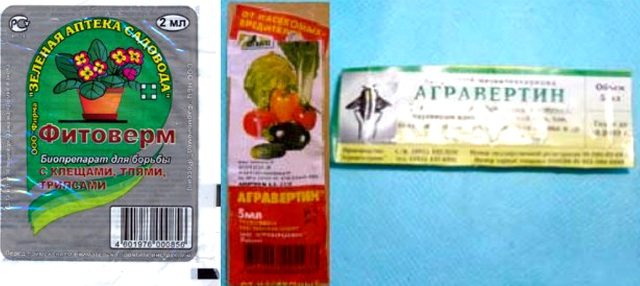

Means "Fufanon", "Aktellik" "Chlorophos" act on stem and shoot gall midges, which are most often called raspberry gnats. Pest larvae form growths on raspberry stems, which break in places of bulges. Chlorophos is used to treat the soil in the raspberry tree twice - after the snow has melted and 10 days after the first treatment. On raspberries, the strawberry weevil parasitizes, which eats flower buds. Get rid of this insect with the drug "Kemifos".
Requirements for conditions
To grow a crop such as remontant raspberry, you need a plot with the following conditions:
- Soil - for the cultivation of remontant raspberries, a highly fertile cohesive sandy or loamy soil with a high content of nutrients, a weakly acidic or close to neutral reaction of the environment is required;
- Light - in the middle lane and northern regions, remontant varieties should be grown in places that are constantly illuminated during daylight hours. In the southern regions, so that the culture does not suffer from the scorching sun, it is planted in partial shade;
- Moisture - raspberries do not tolerate flooding of the root system, therefore, for its cultivation, it is necessary to choose a high place with deep groundwater;
- Protection from cold winds - in order to protect the planting from drafts and cold winds, it should be planted near capital structures, fences, bushes. In this case, it is necessary to ensure that such obstacles to the wind do not obscure the landing.
When to plant
Many experienced gardeners consider spring to be the most favorable time for planting remontant raspberries, but you should not give up the procedure in autumn either.
The main thing is to adequately assess the climatic conditions and take into account the terms that allow the implementation of work.
Lunar calendar
The lunar calendar has long been in demand by summer residents as the main guide, informing about the most suitable time for activity in the garden.
Auspicious numbers in September: 1-4, 7-9, 17-19.
By region
An important criterion in choosing a period for holding events is the climate features of the area where the crop is supposed to be grown.
It is necessary that daylight hours last at least 10-12 hours, and the temperature does not drop below 12 ° C.
Due to the requirements put forward by the variety, planting in the fall is allowed almost throughout the entire territory of Russia. The exceptions are Siberia and the Urals, in them, mainly, snow falls very early, and the fruit bearing does not have time to adapt to temperature fluctuations. In this case, the event is postponed to spring.
Diseases and pests
The resistance of remontant raspberries to various diseases is higher than that of ordinary raspberries, but it is still necessary to provide additional protection. Strong immunity is formed in plants with proper care and adequate nutrition. Timely pruning provides the bushes with access to light and air, preventing the emergence of foci of infection. Placing plantings of remontant varieties away from ordinary ones protects them from damage by common raspberry pests. It is necessary to carefully check the planting material before purchasing for the presence of insects and suspicious growths or tubercles on the roots and stems.
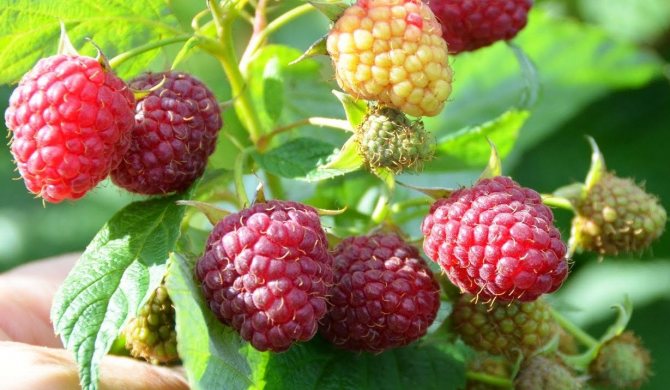

When feeding, you should not get carried away with nitrogen fertilizers, which stimulate the growth of delicate fleshy leaves that attract a variety of caterpillars and aphids. If, in spite of preventive measures, insects - mites, beetles, aphids, weevils and others - are introduced into the raspberry grove, the damaged parts of the plants are cut out and burned. The bushes are treated with a tincture of garlic or onion husks with the addition of laundry soap or powdered with wood ash. In advanced cases, chemical remedies are used - Actellik, Confidor and others.
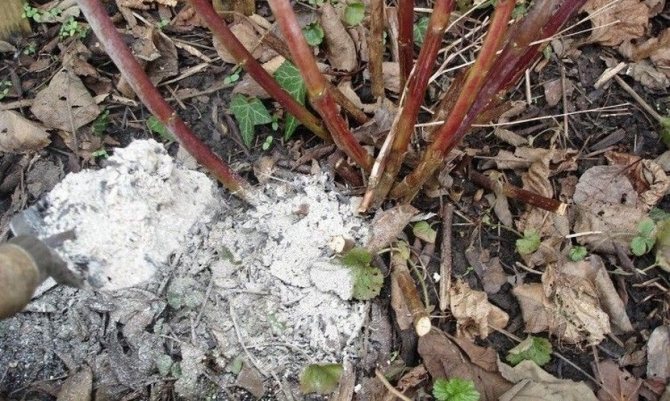

For preventive purposes, in the spring and autumn, plantings are sprayed with Bordeaux liquid. Insects, damaging plants, can introduce pathogens of fungal and viral infections into the wounds, which develop especially rapidly in inclement weather or in thickened plantings. If raspberries are affected by chlorosis or curl, it is impossible to cure the plants and will have to be destroyed. In cases of defeat by fungal infections, such as anthractosis, septoria and various spots, spray the bushes with Bordeaux liquid or nitrophene at the beginning of the growing season, before flowering and after picking berries. In case of severe damage, diseased plants are destroyed.
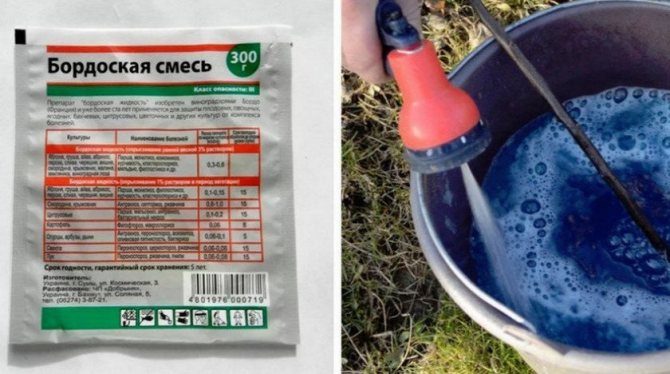

Repairing varieties of raspberries are an excellent addition to ordinary raspberries at their summer cottage. Easier care, high productivity, long-term fruiting and varietal variety allow you to pamper yourself with your favorite berry until late autumn and create decorative compositions in the garden from multi-colored berry constellations.
Successful transplant technology - step by step instructions
Before planting, the seedlings are shortened to a height of 30 ... 40 cm. Planting is carried out without deepening - to the usual depth for the raspberry root.
- prepare holes or trenches on the marked area - 25 ... 35 cm deep;
- spread out the seedlings at the required interval;
- straighten each root in the hole and sprinkle halfway with dry soil.
- water well - at least 10 liters. for 3 seedlings.
- fill the hole to the top with dry soil, lightly tamp the earth.
In order not to remember the seedlings until spring, it is necessary to cover the bed with mulch - compost, dry leaves, any loose organic matter with a layer of at least 7 ... 10 cm.
This completes the preparation for the winter of the newly planted area.
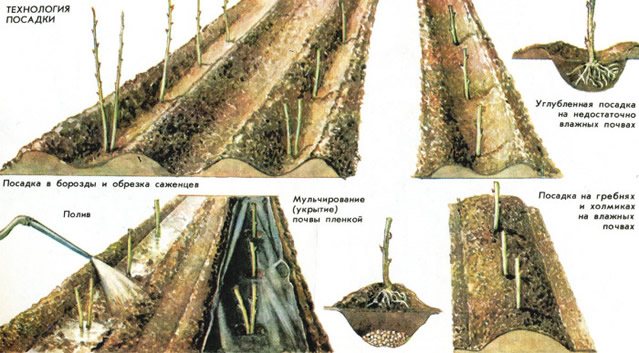

Features of fruiting remontant raspberries
After planting, remontant raspberries begin to bear fruit somewhat later than ordinary ones. In this bush culture, there is an alternation of fruiting shoots - the same shoot yields a harvest in a year. In remontant raspberries, the crop is usually yielded by two- and even three-year-old shoots. Therefore, you should not be too zealous in thinning raspberries and cutting out too old seedlings, they can give a good harvest.
Sometimes, quite rarely, it happens that all planted raspberries begin to bear fruit periodically, after a year. This is offset by a bountiful harvest, but still, most of us would like to receive fresh berries on a regular basis. This usually occurs due to overfeeding with nitrogen and organic fertilizers, or due to the characteristics of the variety. It can also occur due to frost when the raspberry flowers die.
Usually this problem can be solved by feeding with superphosphates or other fertilizers containing it. There are also special spray formulations that provoke flowering and fruiting. If there is a possibility of frost during flowering, take action. As a rule, the first harvest of remontant raspberries is less precisely because part of the color dies from frost. Cover the bushes at night with a special geotextile, or fumigate remontant raspberries at night during frosts.
Top dressing during the growing season
With proper autumn soil preparation before planting remontant raspberries, the next season raspberries do not need fertilizers. In the future, remontant raspberry bushes should be fertilized twice a year. Mineral fertilizers are applied during the active growth of shoots, in June-early July, in August, complex feeding is performed.
Advice! Feed in warm weather, combining it with watering.
Repaired raspberry reacts sharply to a lack of nitrogen, and responds well to organic feeding. Liquid top dressing from mullein in a ratio of 1:10 or fermented bird droppings 1:20 in the amount of 4-5 liters per m2, applied at the beginning of summer, will provide remontant raspberries with the necessary supply of nutrients.
Attention! In autumn, nitrogen fertilizers cannot be applied, since the plant will increase its vegetative mass and will not have time to properly prepare for wintering.


General advice for planting
Raspberry seedlings intended for planting must be healthy, strong, with a large number of small fibrous roots. During transportation, plant roots are wrapped in wet straw or burlap to protect them from drying out. To improve survival, seedlings are soaked in water for 1-2 days.


With any method of planting, the seedlings are buried in the ground level with the root collar. The location of the bushes and the planting scheme are planned in such a way as to provide the possibility of caring for the raspberry, free passage for harvesting and space for installing supports.
Did you know? When crossing raspberries and blackberries, varieties were bred that are resistant to almost all diseases, do not have thorns and root shoots, giving high yields of more fragrant berries with an exquisite taste and the ability to long-term storage.
The ways
There are several ways to plant remontant raspberries in a garden plot - each of them is characterized by its own advantages and disadvantages. The summer resident already independently decides which method to use.


The first thing a gardener should do is choose quality planting material... Its root system must be developed.
Saplings
During planting, you need to take into account the conditions in which the seedlings grew in nurseries.They are deepened in the garden by 4 cm more than it was in the nursery - the root bud must be covered.
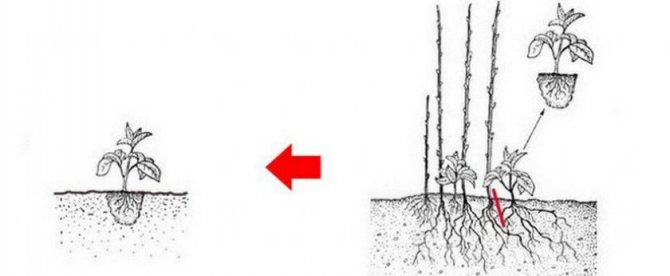

The best varieties of raspberries
Many varieties of this bush have been bred. Therefore, if you are just starting to grow raspberries on your site, you should familiarize yourself with its assortment. Excellent early varieties are:
- Sun.
- Abundant.
- Meteor.
- Cumberland.
- Vega.
- Runaway.
- Flame.
If you are interested in mid-season species, then the most common are the following bushes:
- Polka.
- Giant.
- Hercules.
Key Features
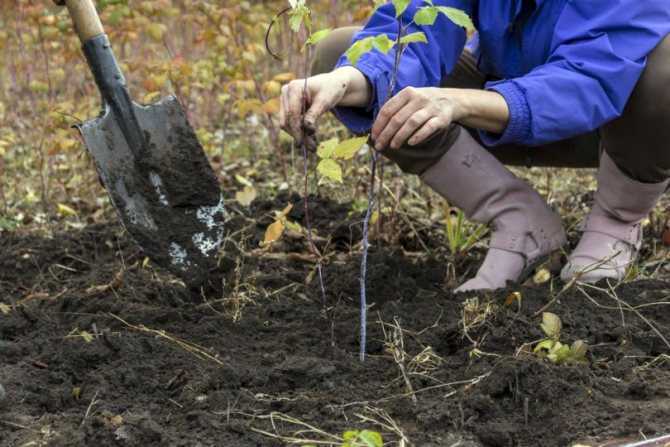

Before choosing this option, familiarize yourself with its differences from the usual types. Consider that remontant options are much higher, therefore, more space is needed for growing, you cannot thicken the plantings. It is imperative to put trellises, without them the stems will lie on the ground. Features are as follows:
- High frost resistance. Almost all species survive the winter well, do not require additional preparation and shelter.
- Resistant to most pests and diseases. Plants are almost not affected, so there is an opportunity to grow ecologically clean berries.
- Formation of many shoots every spring. From each root, from 5 to 8 stems are formed, so the yield is high.
- The berries hold well even after ripening. You can collect them 1-2 times a week, which is convenient when growing in the country.
- Many ovaries are formed. Sometimes it is necessary to cut off individual shoots, to reduce the load on the root part.
- It is necessary to tie up the bushes. Demanding soil nutritional value, as well as lighting, is much higher than that of ordinary raspberries.
- Ripening lasts from mid-July until the first frost. Often the berries do not have time to ripen, they die from the cold.
In fact, it is an improved version of a common crop with very large fruits. The advantage is that remontant varieties are self-pollinated, therefore they normally form ovaries without planting a number of pollinators. But if you do not prepare the planting site correctly, then the yield will be much lower.
When to wait for fruiting after planting?
Getting a crop already in the very first summer is one of the main advantages of autumn planting. But for this plus to be realized, it is necessary to provide the seedlings with proper care. If the youngsters experience a shortage of water, freeze in winter, and become affected by pests, then the harvest for next year will be scarce or the raspberries will not produce berries at all.
Conditions for harvesting next year:
- correct planting - healthy planting material, fertilization, etc.;
- ensuring normal soil moisture;
- careful shelter for the winter - in accordance with winter temperatures;
- tillage under the bushes with Karbofos - 10 ml per bucket of water (calculated for one bush);
- treat the soil with a solution of copper sulfate - from fungi and lichens.
If the seedlings survive the winter safely and receive proper care in the spring, then the first berries will appear in July-August, depending on the ripening time of the variety.
The hardest part about planting any crop in the fall is choosing the right moment. If the planted raspberries dissolve the buds before the frost, you will not have to rely on the harvest. Otherwise, planting raspberries in the fall is simple, and represents a standard set of agrotechnical measures.
1
How to choose a place for a new raspberry tree?
It is not only the time of transplant that you need to be able to choose correctly. The landing site must meet many requirements. If the ground or place is bad, the plant simply will not take root, or this process will stretch, and the new raspberry tree will freeze out at the first frost. Which place is right?
The place should be open, sunny, but on one side protected by a wall, fence or natural fence (shrubs, hills). This is necessary to prevent young raspberries from falling in autumn or winter under strong winds.However, the fence can be installed on purpose, at the time of the rooting of the sprouts, but you cannot artificially lead the sunlight, so the place should be illuminated from all sides. Partial shade is possible, since in the summer in the sun, one way or another, you have to arrange artificial sheds for raspberries.
Transplanting raspberries in a new place in the fall should be carried out only on fertile, drained soil with moderate acidity. Waterloggedness is unacceptable! If nothing has grown on the site before, a month before transplanting it is necessary to dig it up so that the grass “goes” underground. Rotting, it will feed the roots of the shrubs for the first time.
Correct distance between bushes
So much space is left between the raspberry bushes so that they grow comfortably, are well lit, ventilated, and are accessible for care. The distance between the bushes depends on the planting method:
- If raspberries are planted in rows, there should be at least 70-100 cm between adjacent seedlings. Between rows - 1-1.5 m. It is allowed to plant no more than 2 seedlings in one hole.
- If the belt method is used, the pitch in the rows is 35-50 cm. The distance between the belts is 1.8-2 m.
Selection and preparation of planting material
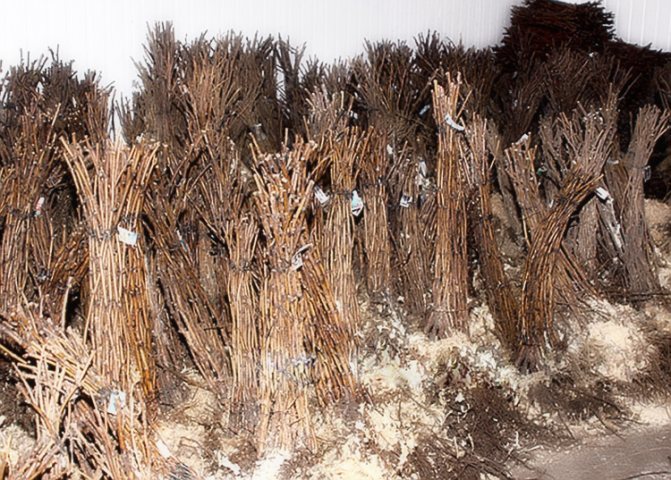

Choosing seedlings
- Experienced gardeners prefer twigs with medium-sized shoots. Too thin can be weak and unable to overwinter. Thick, stiff and rough stems are old and will not take root and bear fruit well;
- It is important to carefully examine the roots - they must be well developed, not dry, not damaged;
- One raspberry bush seedling should have up to 3 shoots. With a larger quantity, the bush will develop worse. It is more expedient to get new shoots already in a new place - it will be much healthier and more powerful;
- The seedlings and rhizomes themselves should be slightly damp, wrapped in a fabric that allows air to pass through. If the seedling is wrapped in plastic wrap, there is a risk of acquiring a bush with a rotted root system. Such a plant is not worth buying, since it is not known how long it spent in the package, therefore, the bush may not take root;
- The length of raspberry shoots should not exceed 70 cm. In tall seedlings, energy will be spent on feeding the entire length of the shoot, which will slow down rooting, further development and fruiting;
- You should not buy leafy seedlings, as they were dug out during the period of sap flow. Such seedlings will not take root;
- It is worth paying attention to the appearance of the seedlings themselves: the trunks are not swollen, there are no cracks and rotten areas. The seedlings should look strong and healthy.
If at the time of purchase the bush was not wrapped in a cloth, you need to remember that the rhizome dries out very quickly, especially in direct sunlight!
Preparing plants for transplanting
- Check the stems for damage;
- Check the roots for rotten areas;
- Disinfect: prepare a clay mash (clay, biologically active drugs Kornevin or Heteroauxin, Rostkontsentrat, humates, etc. are mixed into the water) and dip the seedlings in it before planting. This procedure will protect young bushes from pests and diseases.



